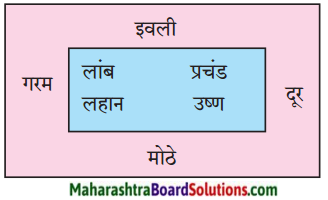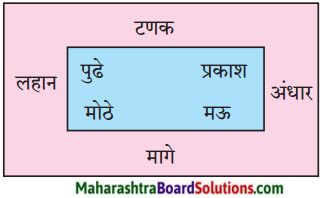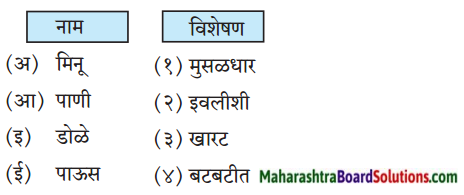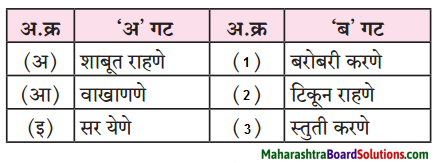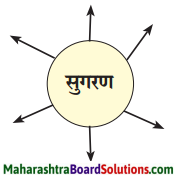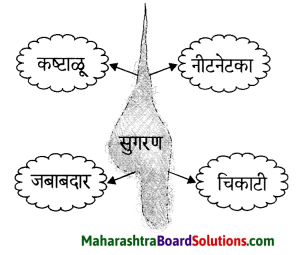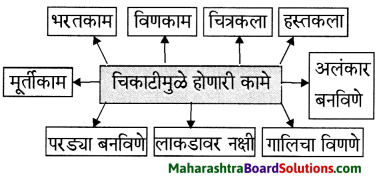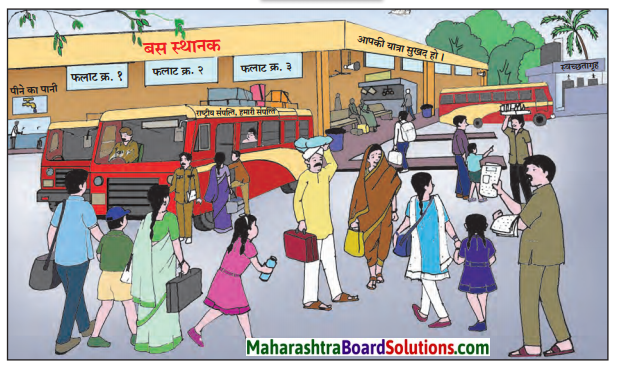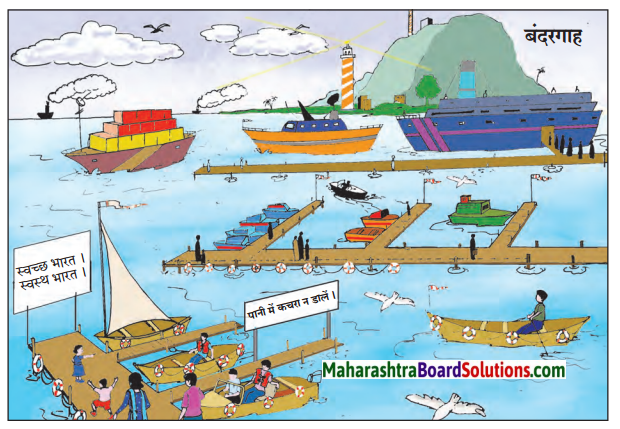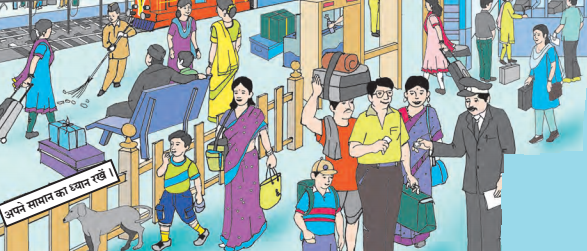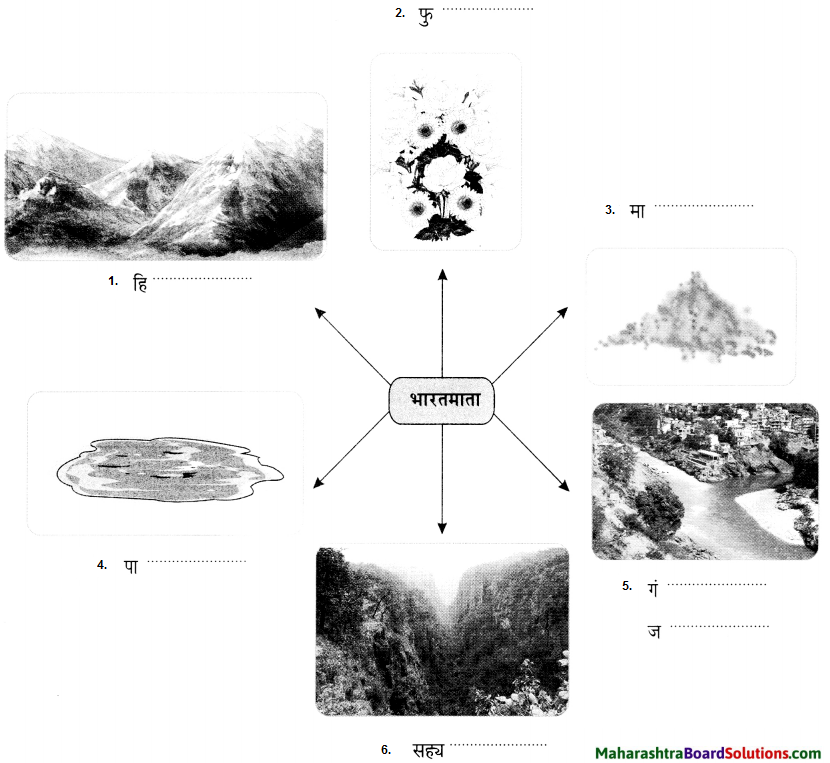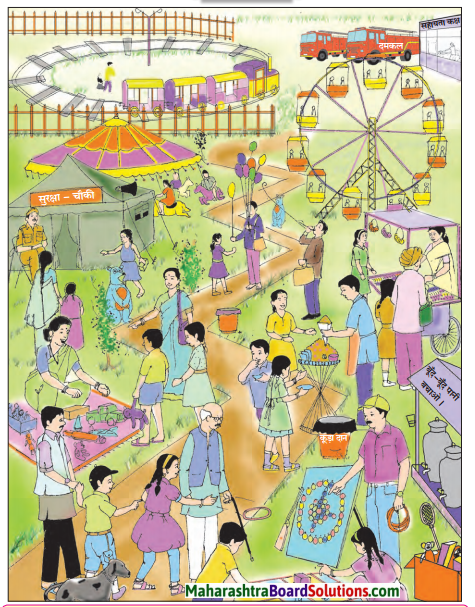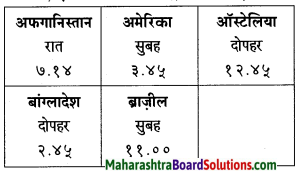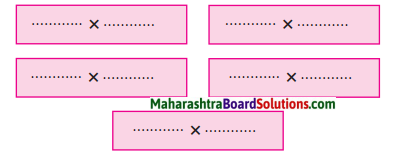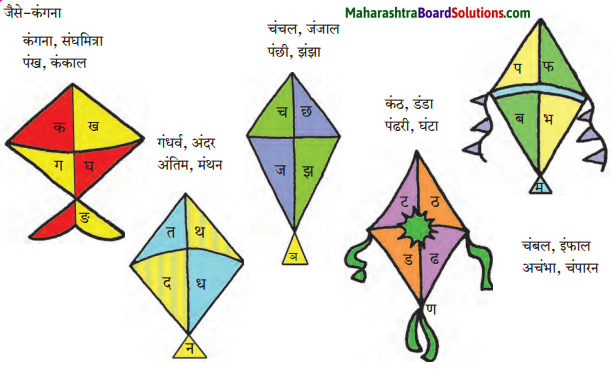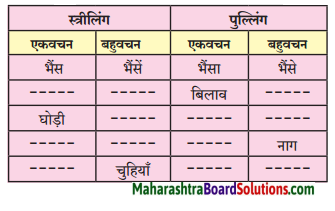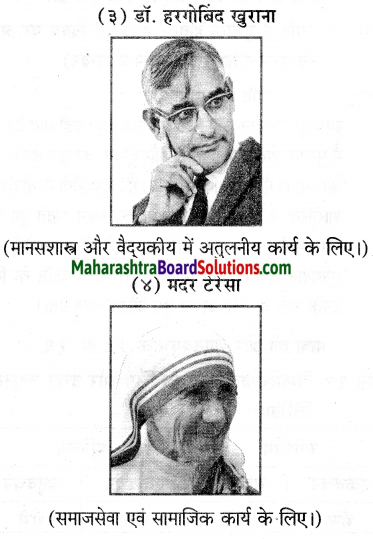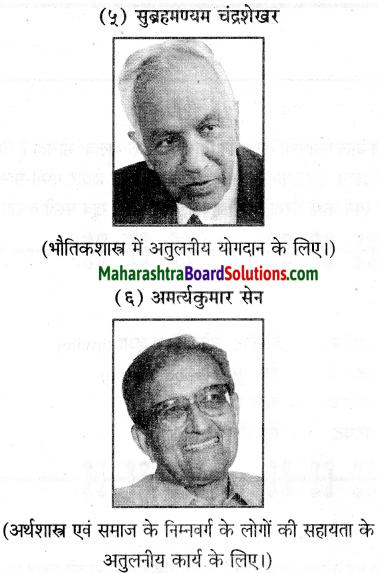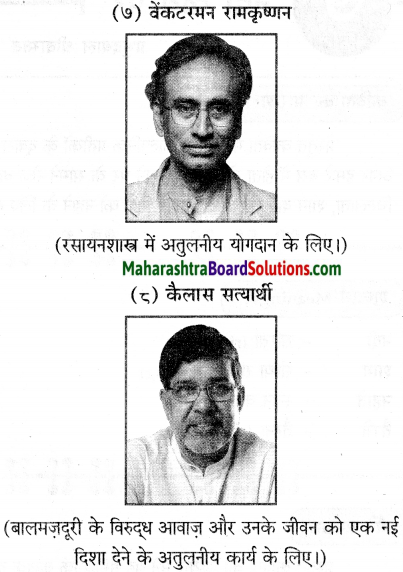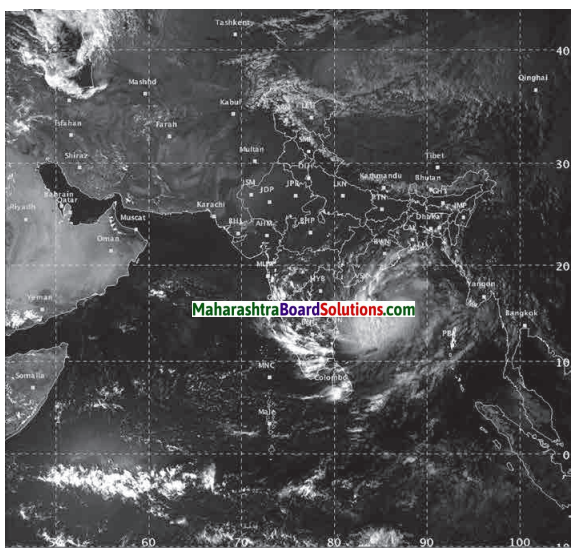Balbharti Maharashtra State Board Class 6 Hindi Solutions Sulabhbharati Chapter 3 कठपुतली Notes, Textbook Exercise Important Questions and Answers.
Maharashtra State Board Class 6 Hindi Solutions Chapter 3 कठपुतली
Hindi Sulabhbharti Class 6 Solutions Chapter 3 कठपुतली Textbook Questions and Answers
विशेषता हमारी
चित्र देखकर विशेषणयुक्त शब्द बताओ और उनका वाक्यों में प्रयोग करो।

Answer:
(१) तालाब में सुनहरी मछली तैर रही है।
(२) बगीचे में लाल गुलाब खिले हैं।
(३) माँ ने आज स्वादिष्ट सब्जी बनाई है।
(४) थैली में एक लीटर दूध है।
(५) राजू का कक्षा में प्रथम क्रमांक आया।
(६) मोहन के पास दस पेन हैं।
(७) मेरे पास सुंदर लिखावट वाली पुस्तक है।
(८) पहाड़ पर कई ऊँचे पेड़ हैं।
![]()
जरा सोचो… लिखोः
“यदि तुम्हें अलादीन का चिराग मिल जाए तो…” विषय पर अपने विचार लिखिए: (काल्पनिक लेखन)
Answer:
यदि मुझे अलादीन का चिराग मिल जाए तो उसमें से निकलने वाले जिन्न को बोलकर मैं मेरे मन की सारी आशाएँ पूर्ण करूंगा। मैं उसे सबको सुखी और संपन्न बनाने का आदेश दूंगा। जो भूखे-प्यासे हैं, उन्हें भरपेट अन्न देने के लिए कहूँगा। जो दुखी और उदास हैं, उनके दुःखों को दूर करने का अनुरोध जिन्न से करूंगा। मैं उस चिराग का उपयोग समाज के लोगों के भले के लिए करूंगा। मैं स्वयं से ज़्यादा दूसरों के भले के लिए उस चिराग का उपयोग करूँगा।
भाषा की ओर:
निम्नलिखित शब्दों में उपसर्ग लगाकर लिखिए:
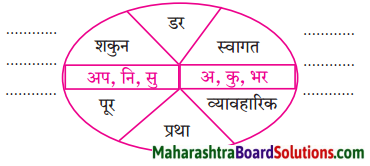
- शगुन
- पूर
- प्रथा
- व्यावहारिक
- स्वागत
- डर
Answer:
- अपशगुन
- भरपूर
- कुप्रथा
- अव्यावहारिक
- सुस्वागत
- निडर
![]()
स्वयं अध्ययनः
आपके पास उपलब्ध सामग्री से कठपुतली बनाओ और किसी कार्यक्रम में उसका मंचन करो।
Answer:
(छात्र यह कार्य स्वयं करेंगे।)
खोजबीन:
पाठ्यपुस्तक पृष्ठ क्र. ३६ “प्रश्न १४. अंधश्रद्धा के कारण एवं उसे दूर करने के उपाय ढूँढ़कर किसी एक प्रसंग को प्रस्तुत कीजिए:
Answer:
(छात्र स्वयं करेंगे।)
कारण:
- प्राचीन परंपराओं-रूढ़ियों को अपनाना।
- स्वयं (मनुष्य) का मन कमज़ोर होना।
- कही – सुनी बातों पर विश्वास करना।
- मृत्यु और कुछ अनहोनी होने का भय होना।
- समाज के डर से प्राचीन रीतियाँ अपनाना।
- शिक्षा का अभाव।
- वैज्ञानिक सोच का अभाव।
उपाय:
- प्राचीन परंपराएँ और रूढ़ियाँ जो योग्य और तर्कसंगत हैं, केवल उन्हें ही अपनाना।
- मनुष्य के मन को गलत एवं भ्रामक कल्पनाओं को दूर करना।
- वैज्ञानिक सोच एवं दृष्टिकोण लोगों में निर्माण करना।
- लोगों को शिक्षित करना एवं अंधश्रद्धा के बारे में जानकारी देना।
- अंधविश्वास उन्मूलन जैसे कार्यक्रमों का प्रचार-प्रसार करना।
- लोगों की वैज्ञानिक सोच और तार्किक शक्ति जागृत करना।
![]()
सुनो तो जरा:
चुटकुले, पहेलियाँ सुनो और किसी कार्यक्रम में सुनाओं
Answer:
(छात्र स्वयं करेंगे।
बताओ तो सही:
किसी एक संस्मरणीय घटना का वर्णन कीजिए: (संस्मरण लेखन)
Answer:
कई वर्ष पहले की बात है। मैं मेरे छोटे भाई के साथ मेरा दसवीं कक्षा का परिणाम देखने विद्यालय जा रह्य था। इतने में एक काली बिल्ली रास्ता काटती हुई चली गई। छोटा भाई तुरंत तीन कदम पीछे खिसकने लगा। मैं भी यह दृश्य देखकर डर गया। मुझे लगा कि न जाने मेरा परीक्षा परिणाम क्या होगा? मैं पूरी तरह से डरा हुआ था क्योंकि काली बिल्ली ने रास्ता काटा था। कई लोगों से सुना था कि बिल्ली के रास्ता काटने से काम नहीं होता, किंतु मैने विद्यालय जाकर जब परीक्षा परिणाम देखा तो मैं अच्छे अंकों से उत्तीर्ण हो चुका था। तब मुझे अपने आप पर विश्वास हो गया कि स्वयं के कर्म पर भरोसा होने पर कोई भी बुरी शक्ति हमारा कुछ नहीं बिगाड़ सकती। असल में हमारे मन का किसी प्रकार पर अति विश्वास ही अंधविश्वास कहलाता है। यह घटना आज भी मुझे याद है।
वाचन जगत से:
छात्र हितोपदेश के आधार पर कोई कहानी पढ़ेंगे एवं उससे संबंधित चित्र बनाएँगे:
Answer:
(छात्र स्वयं करेंगे।)
![]()
मेरी कलम से:
हिचकी आने जैसी क्रियाओं की सूची बनाकर उनके कारण लिखिए:
- हिचकी आना
- हाथ-पाँवों में झनझनाहट होना
- होंठ सूखे पड़ना
- मितली आना
Answer:
- शरीर में ऑक्सीजन (प्राणवायु) और पानी की कमी के कारण।
- शरीर में रक्त का प्रवाह ठीक ढंग से न होने के कारण।
- शरीर में पानी की कमी होने के कारण।
- अपचन और योग्य आहार न लेने के कारण।
अध्ययन कौशल:
नए शब्दों को शब्दकोश में से ढूँढकर वर्णमाला के क्रमानुसार लिखिए:
Answer:
(छात्र स्वयं करेंगे।)
सदैव ध्यान में रखोः
बिना सोचे – समझे किसी बात पर विश्वास ना करें:
Answer:
मनुष्य को अपना प्रत्येक कार्य सोच-समझकर करना चाहिए। दूसरे की बात पर विश्वास करके या बिना किसी जाँच – पड़ताल किए दूसरे पर विश्वास करने वाले मनुष्य को अंत में हानि ही उठानी पड़ती है।
![]()
विचार मंथन:
विज्ञान का फैलाओगे प्रकाश तो होगा अंधविश्वास का नाश। (अनुच्छेद लेखन)
Answer:
प्रस्तुत कथन का अर्थ यह है कि संसार में प्रत्येक घटना के घटित होने के पीछे भौगोलिक या वैज्ञानिक कारण होता है। प्रत्येक घटना को अगर हम विज्ञान की कसौटी पर जाँच कर देखेंगे, तो हमें उत्तर मिलेगा कि संसार में कोई घटना बिना वजह घटित नहीं होती। अंधविश्वास बिना सोची-समझी बातों को करने से बढ़ता है। अत: विज्ञान के प्रकाश से ही हम अंधविश्वास का नाश कर सकते हैं।
नीचे दी गई संज्ञाओं का वाक्यों में प्रयोग करो ।
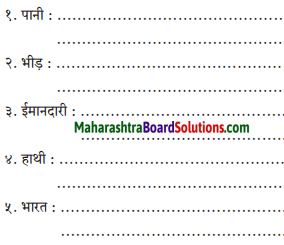
Answer:
(१) पानी
पानी के बिना मनुष्य का जीवन व्यर्थ है।
(२) भीड़
भीड़ में खड़े कई लोग चिल्ला रहे थे।
(३) ईमानदारी
हमें अपना काम ईमानदारी से करना चाहिए।
(४) हाथी
हाथी एक बड़ा जानवर है।
(५) भारत
भारत मेरा देश है।
![]()
नीचे दिए सर्वनामों के चित्र देखो, पहचानो और वाक्यों में प्रयोग करो।
(तुम, कोई, हम, आप)
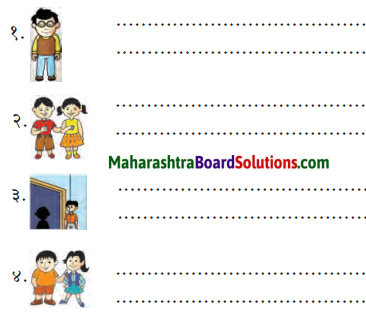
Answer:
(१) वह लड़का खड़ा है।
(२) लड़का और लड़की वो दोनों मुस्कुरा रहे है।
(३) लड़का अपनी परछाई को देख रहा है।
(४) यहा लड़का लड़की को कुछ समझा रहा है।
Hindi Sulabhbharti Class 6 Solutions Chapter 3 कठपुतली Additional Important Questions and Answers
निम्नलिखित वाक्यों में सही विकल्प चुनकर वाक्य फिरसे लिखिए:
Question 1.
एक कठपुतली हाथ में एक ……………… लेकर आई।(छड़ी, फूल, नारियल)
Answer:
एक कठपुतली हाथ में एक नारियल लेकर आई।
Question 2.
सारी कठपुतलियाँ ……………… खड़ी हो गई। (ठिठककर, भागकर, सहमकर)
Answer:
सारी कठपुतलियाँ ठिठककर खड़ी हो गई।
![]()
Question 3.
जिसे लोग …………….. समझते हैं। (श्रद्धा, विश्वास,अंधविश्वास)
Answer:
जिसे लोग अंधविश्वास समझते हैं।
Question 4.
सारा ………….. ही छींक रहा है। (शहर, मोहल्ला, नगर)
Answer:
सारा मोहल्ला ही छींक रहा है।
Question 5.
अब ……………… भरपूर मज़ा लेने लगे। (वक्ता, दर्शक, पाठक)
Answer:
अब दर्शक भरपूर मज़ा लेने लगे।
निम्नलिखित वाक्यों को कहानी के आधार पर पूरा कीजिए:
Question 1.
प्रीति अपने मित्र तेजस, प्रसन्ना और मृण्मयी के साथ
Answer:
महोत्सव देखने आई थी।
Question 2.
“आइए, आइए, हमें गलत साबित करके
Answer:
हजार रुपये ले जाइए
Question 3.
……………….. कि कठपुतलियाँ बोल रही हैं।
Answer:
आवाज तो विद्यार्थियों की है, पर लगता है ।
![]()
Question 4.
……………… नारियल फोड़कर किया जाता है।
Answer:
किसी भी नए कार्य का प्रारंभ
Question 5.
परिणाम कार्य की अपूर्णता और ……………
Answer:
नाम शकुन – अपशकुन का
निम्नलिखित वाक्य सही हैं या गलत लिखिए:
Question 1.
प्रीति अपने मित्रों के साथ चिड़ियाघर गई थी।
Answer:
गलत
Question 2.
नए कार्य की शुरुआत हम नारियल फोड़कर करते हैं।
Answer:
सही
Question 3.
नारियल से फूल निकलना यह एक चमत्कार है।
Answer:
गलत
![]()
Question 4.
बिल्ली के रास्ता काटने से अपशकुन होता है।
Answer:
गलत
Question 5.
हमें अंधविश्वास से दूर रहना चाहिए।
Answer:
सही
निम्नलिखित प्रश्नों के उत्तर एक-एक वाक्य में लिखिए:
Question 1.
शहर में किस का आयोजन किया गया था?
Answer:
शहर में आनंद महोत्सव का आयोजन किया गया था।
Question 2.
बोर्ड पर क्या लिखा था?
Answer:
बोर्ड पर यह लिखा था कि हमें गलत साबित करके एक हजार रुपए ले जाइए।
Question 3.
नए कार्यक्रम का आरंभ क्या फोड़कर किया जाता है?
Answer:
नए कार्यक्रम का आंरभ नारियल फोड़कर किया जाता है।
Question 4.
लल्लन की चक्की पर क्या पिसाई जा रही थी?
Answer:
लल्लन की चक्की पर हरिकिशनदास के यहाँ की शादी की मिरची पिसाई जा रही थी।
![]()
Question 5.
प्रत्येक घटना के पीछे क्या होता है?
Answer:
प्रत्येक घटना के पीछे कोई न कोई वैज्ञानिक या व्यावहारिक कारण होता है।
Question 6.
प्रीति अपनी बुआ को क्या बताने वाली थी?
Answer:
प्रीति अपनी बुआ को बताने वाली थी कि विश्वास करो, अंधविश्वास नहीं।
निम्नलिखित प्रश्नों के उत्तर दो-तीन वाक्यों में लिखिए:
Question 1.
मनुष्य उचित फल से कभी-कभी बंचित क्यों रहता है?
Answer:
मनुष्य कभी-कभी शगुन-अपशगुन के दायरे में अटका रहता है। जिस कारण वह अपना काम समय पर पूरा नहीं करता और उसका असर उसके काम पर पड़ने के कारण ही उसे अपने फल से वंचित रहना पड़ता है।
Question 2.
लोगों एवं बच्चों को किस प्रकार की दुकानें आकर्षित कर रही थीं?
Answer:
लोगों एवं छोटे बच्चों को विविध कलाओं के दर्शन, खेल, प्रदर्शनी, मौत का कुआँ, छोटे – बड़े झूले, कठपुतली का नृत्य और खाने – पीने की दुकानें आकर्षित कर रही थीं।
Question 3.
सूत्रधार के कहने पर भीतर जाने पर प्रीति और उसके मित्रों ने क्या देखा?
Answer:
सूत्रधार के कहने पर भीतर जाकर प्रीति और उसके मित्रों ने देखा कि कठपुतलियाँ रंग-बिरंगे पहनावे पहनकर आँखें मटकाती हुई इधर से उधर आ-जा रही हैं। लोगों का स्वागत कर रही हैं।
![]()
Question 4.
प्रयोग के समय जादूगर नारियल से फूल कैसे निकालते हैं।
Answer:
प्रयोग करने वाले नारियल के तीन छेदों में से एक छेद को सलाई की सहायता से खोलकर उसमें मोगरे या चमेली की कलियाँ डाल देते हैं। प्रयोग के समय तक वे खिलकर फूल बन जाती हैं। इस प्रकार जादूगर नारियल से फूल निकालते हैं।
व्याकरण और भाषाभ्यास
निम्नलिखित शब्दों के समानार्थी शब्द लिखिए:
- मौत
- नमस्कार
- प्रारंभ
- रास्ता
- कार्य
- विलंब
- असर
- वैज्ञानिक
Answer:
- मृत्यु
- प्रणाम
- आरंभ, शुरुआत
- पथ, मार्ग
- कर्म
- देरी
- परिणाम
- शास्त्रीय
![]()
निम्नलिखित शब्दों के विलोम शब्द लिखिए:
- शकुन
- अंदर
- आज
- पूर्ण
- श्रद्धा
Answer:
- अपशकुन
- बाहर
- कल
- अपूर्ण
- अंधश्रद्धा
![]()
निम्नलिखित शब्दों का वचन बदलकर लिखिए:
- कठपुतली
- बिल्ली
- कली
- सलाई
- लड़ाई
- ताली
- लड़की
- गिलहरी
Answer:
- कठपुतलियाँ
- बिल्लियाँ
- कलियाँ
- सलाइयाँ
- लड़ाइयाँ
- तालियाँ
- लड़कियाँ
- गिलहरियाँ
![]()
निम्नलिखित विशेषणों के साथ संज्ञा शब्द की जोड़ियाँ मिलाइए:
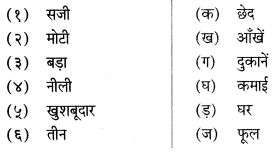
Answer:
१ – ग
२ – घ
३ – ड
४ – ख
५ – ज
६ – क
